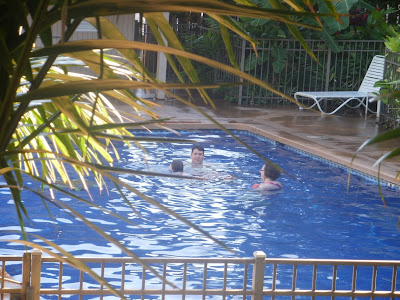Recently, we were able to pull our first honey from the hive. You might be surprised at how many steps there are to harvesting honey. I wasn't able to get the first parts photographed since I don't have a bee suit (and am not willing to be stung for documentation purposes). Mike, however, does have a bee suit, and actually, he is the one who works with the hives. So, what you don't see here is the smoking to calm the bees during check-ups and harvest, the lifting of the lid, prying out the frames to find those that are ready to harvest, and transporting them back to our house where the extraction process happens. We'll begin the photo essay from there...
Each frame is heavy with liquid gold, hiding inside beeswax. Don't worry, we leave plenty for the bees to survive on. Plus there's the bonus of something or other blooming year-round in the tropics.
Before we can get to the honey, we have to open up the caps that seal each cell of the comb. The first time we did this, we used a homemade scraping tool. We have since moved on to a pin roller which makes the job much easier and also leaves fewer of the cappings in the honey, and a lifting fork for the bits where it might be too uneven for the roller.
Next, the frames, three at a time, go into the hand-crank extractor. After you're done spinning the honey out of one side, you turn each around to get the other side extracted. The extractor has just enough room on the bottom to hold the honey from these three frames (about 2-1/2 gallons) before it needs emptying, so we'll drain it out the spout before doing the next three frames.
We'll have to lift the whole thing up high enough to get a five-gallon bucket underneath. The honey pours out of the valve near the bottom and runs through a strainer to catch the cappings and other bits of wax that got loose. This wax, along with the wax scraped from the spent frames, will be melted before being used to create candles, salves, etc. We'll need a sunny day to do this - but it's the rainy season, so we are storing the unrefined beeswax in the freezer for now.
Once the pure honey is in the big bucket, we can fill our honey jars...
... and since it's been such a good harvest, we have extra to sell!
Kaimu Rainforest Honey - like our label? These one pound jars sell for $5. If you are on-island, you can bring your own jars for a discount. Local, raw, pure, unfiltered honey from deep in the wilds of Puna. Mmmmm... or should I say Bzzzzzzz...





















































